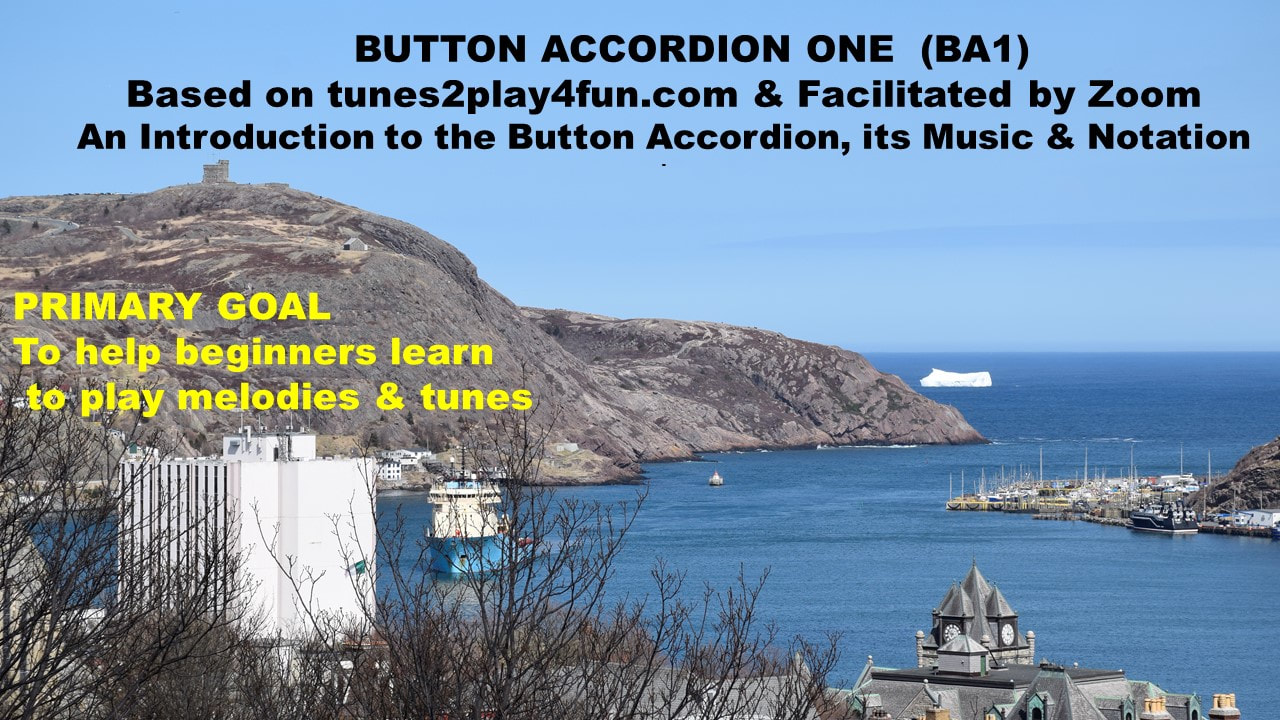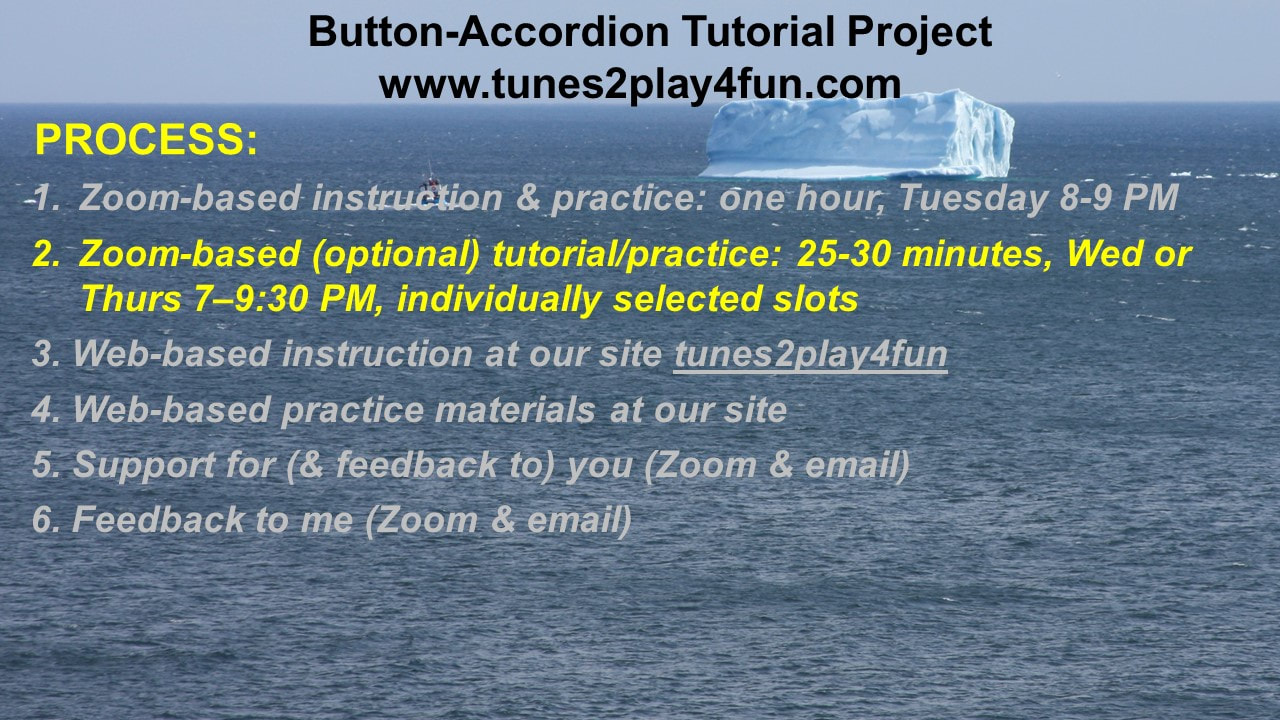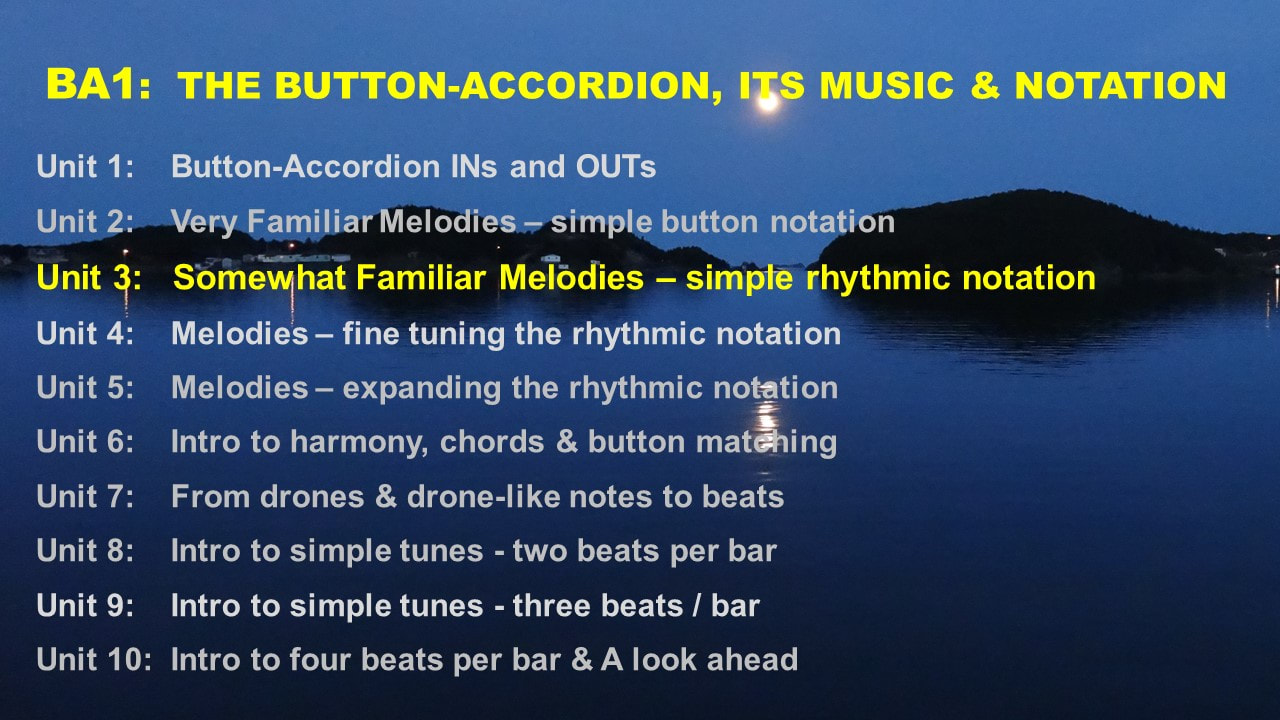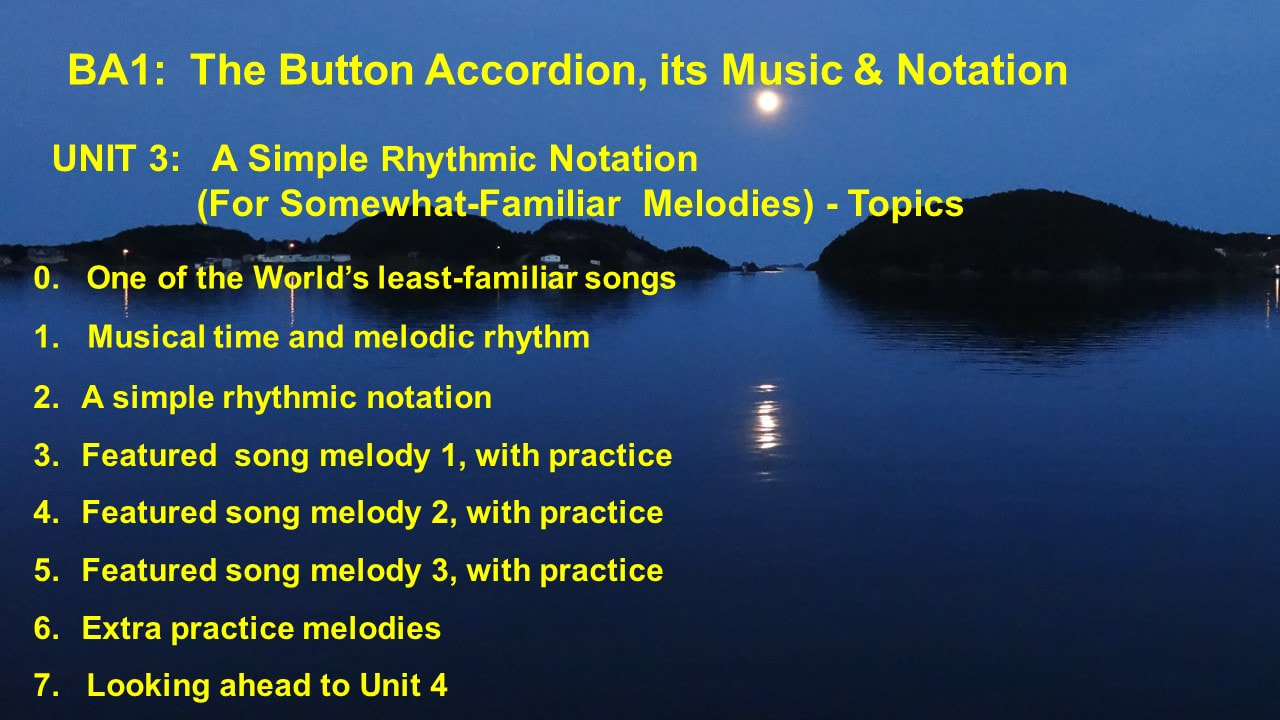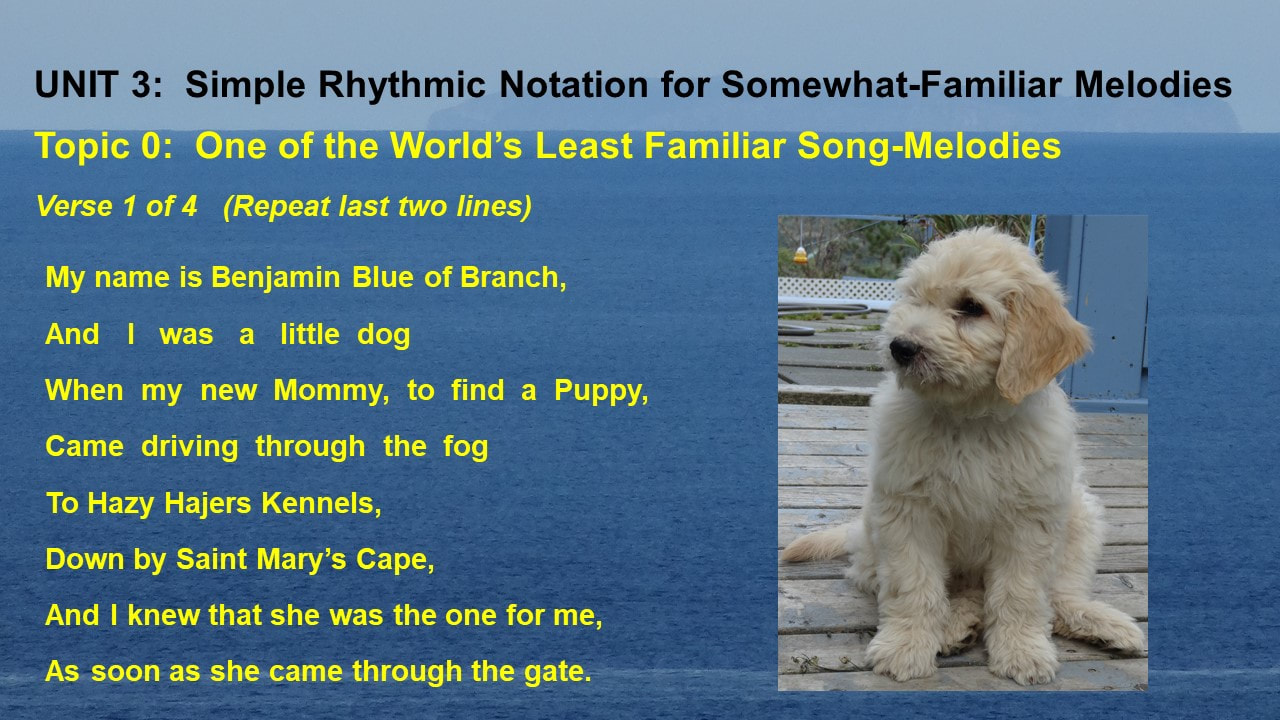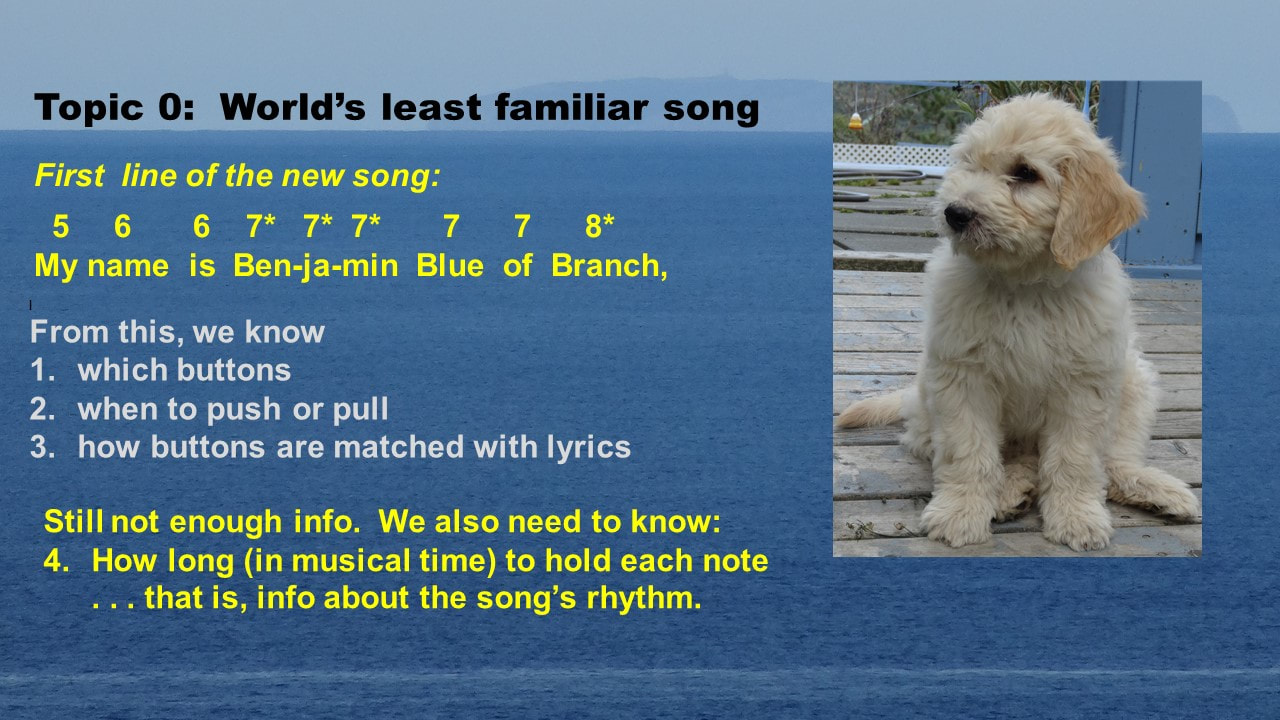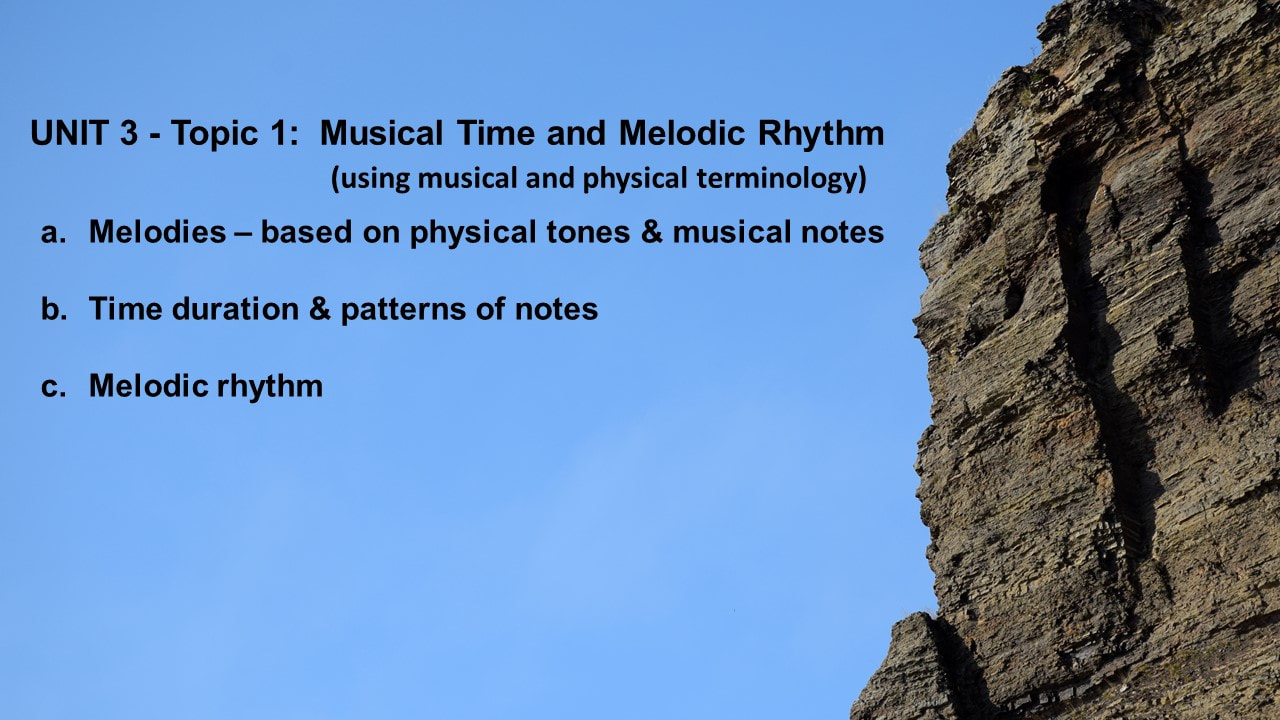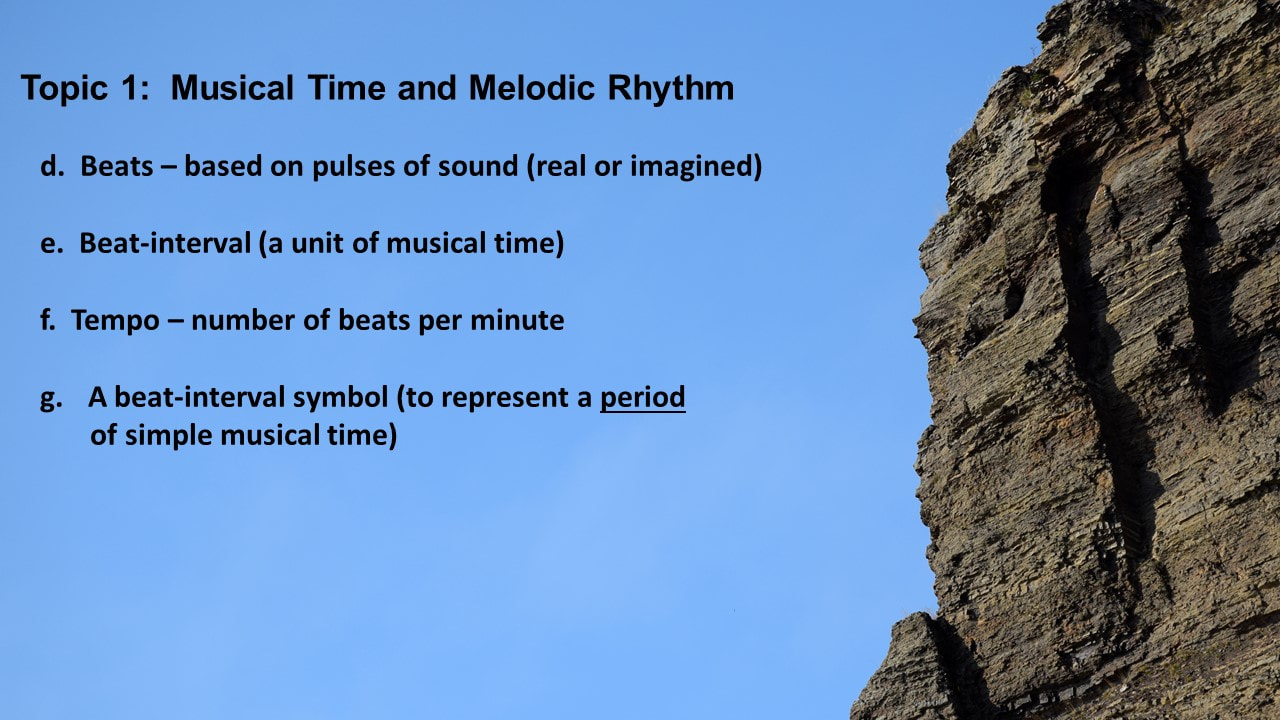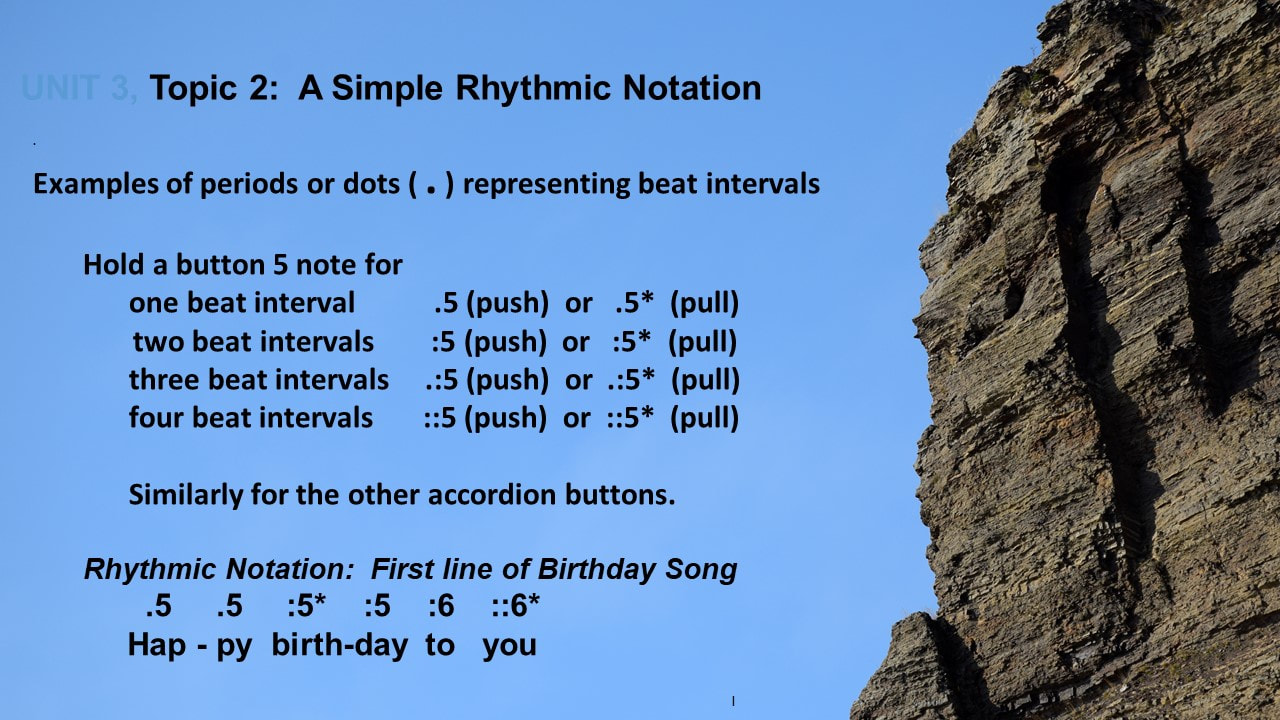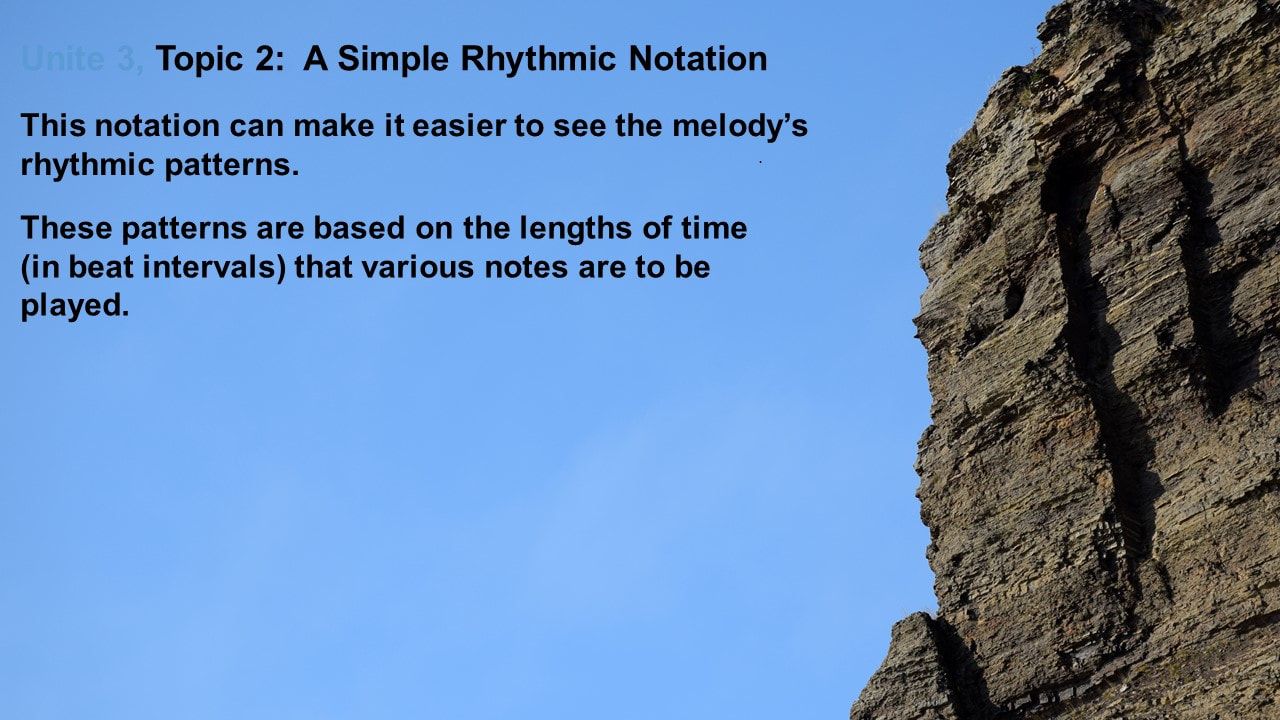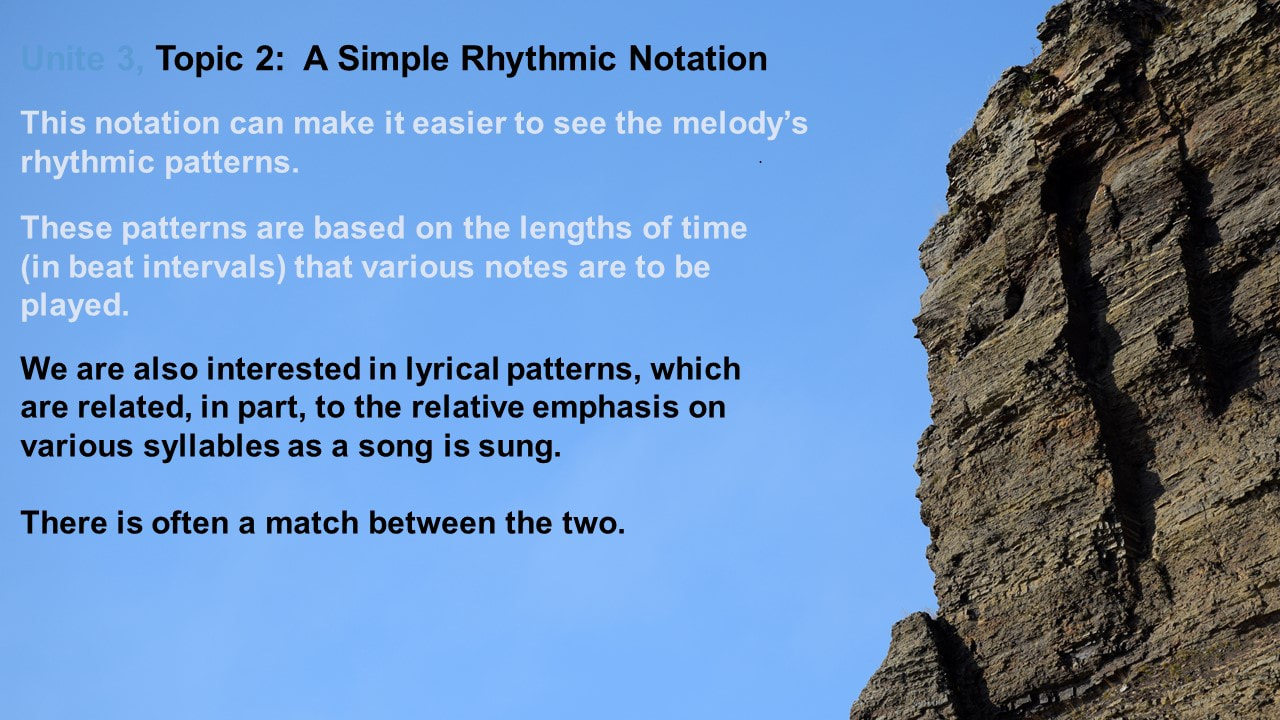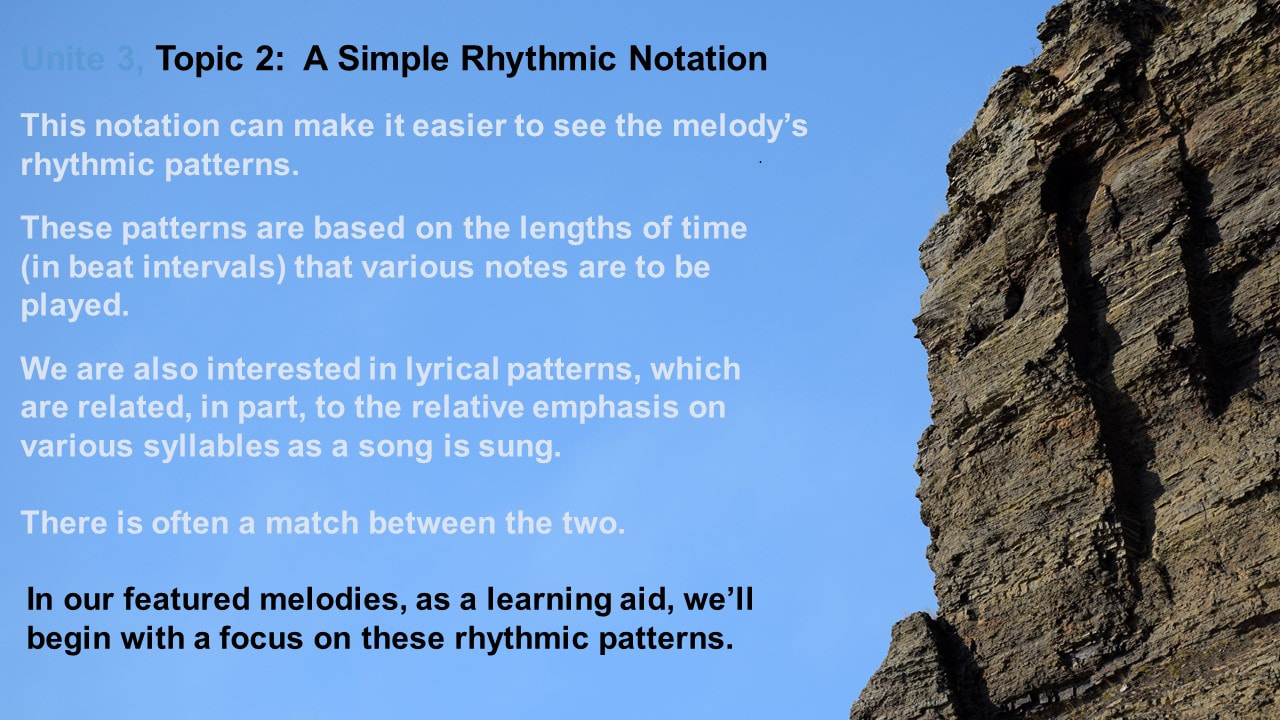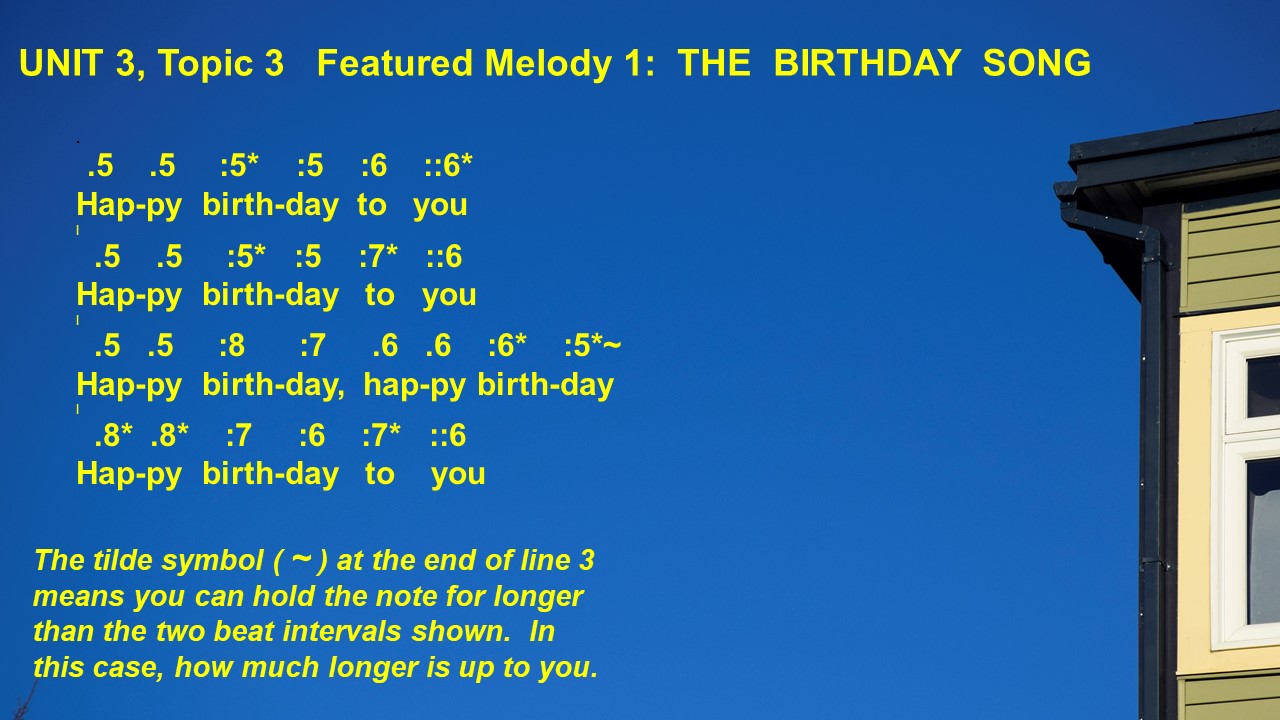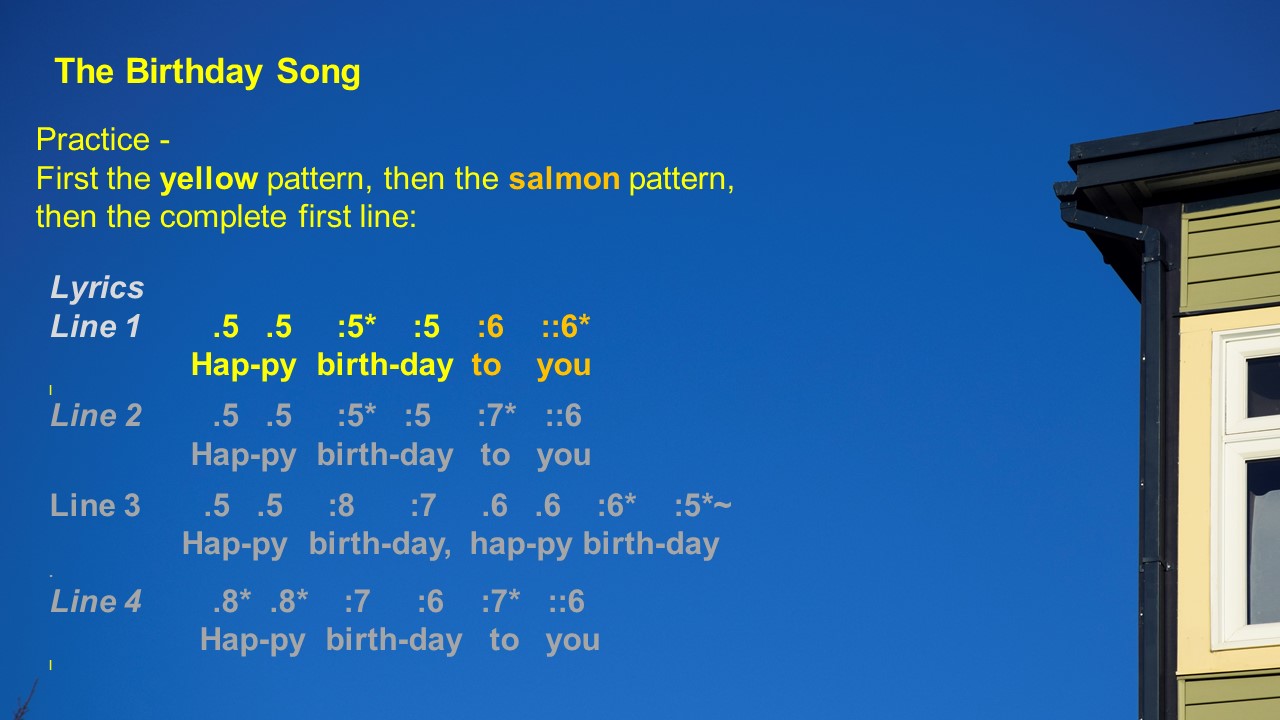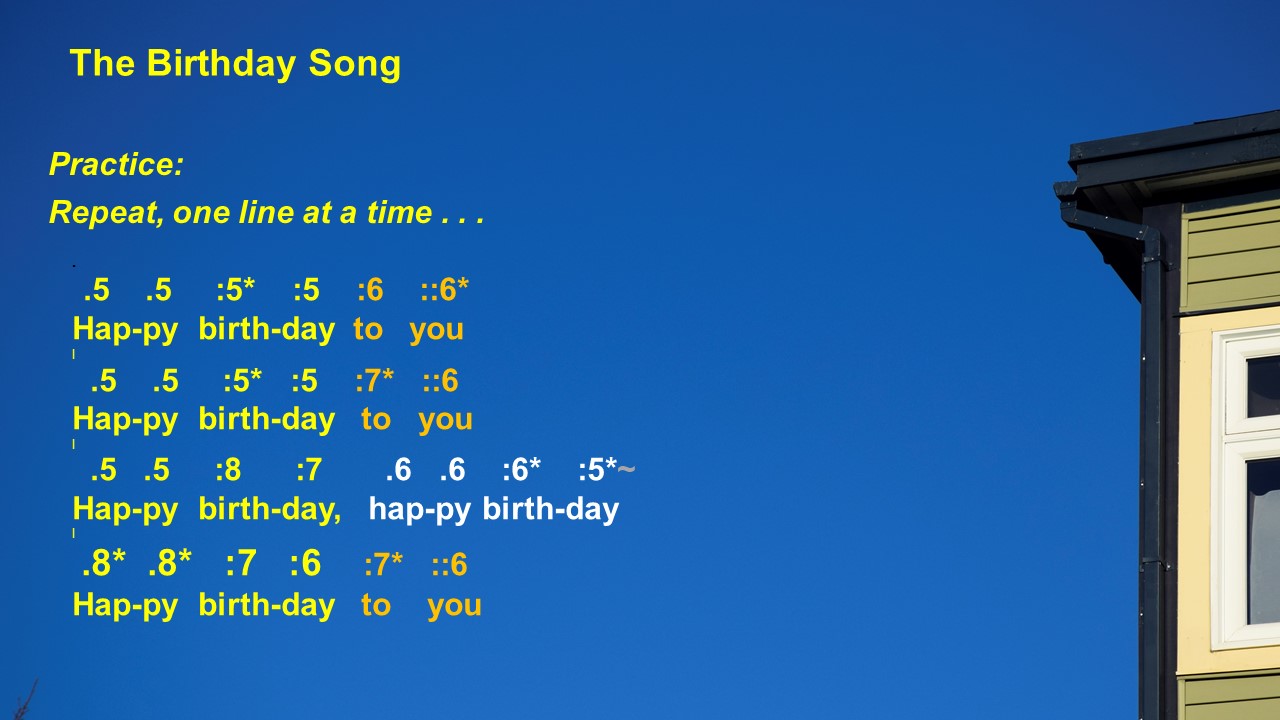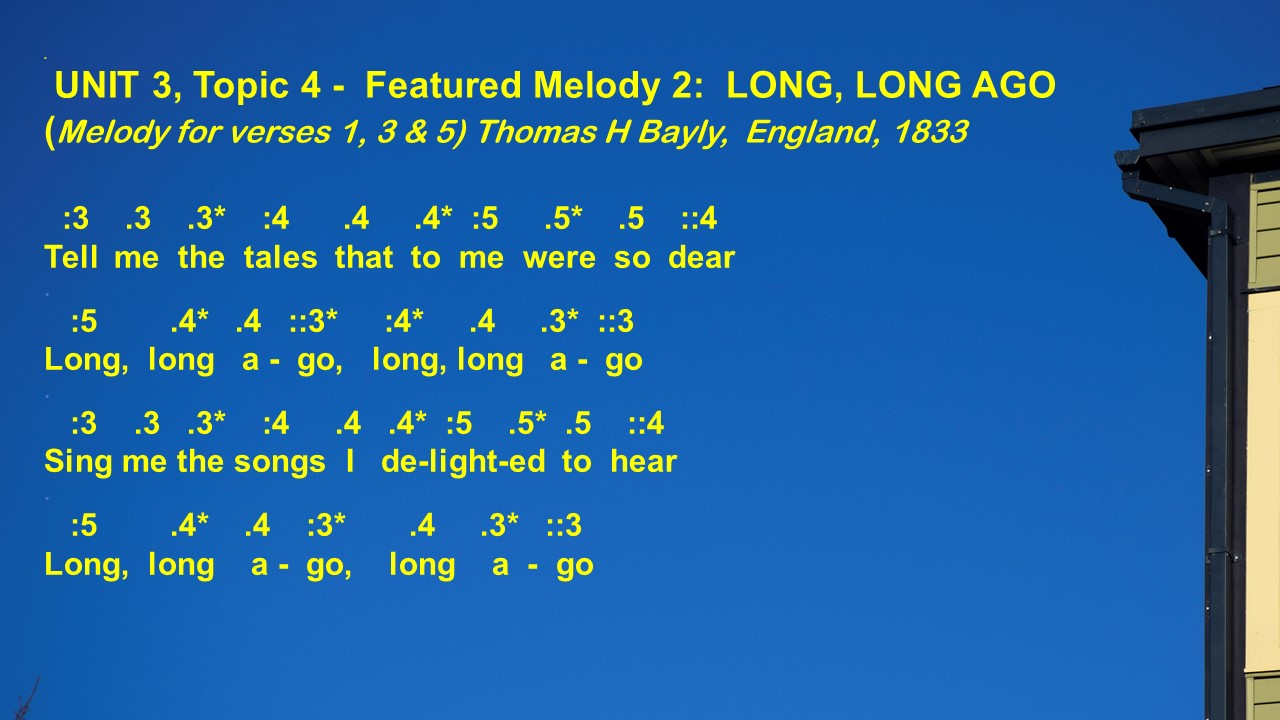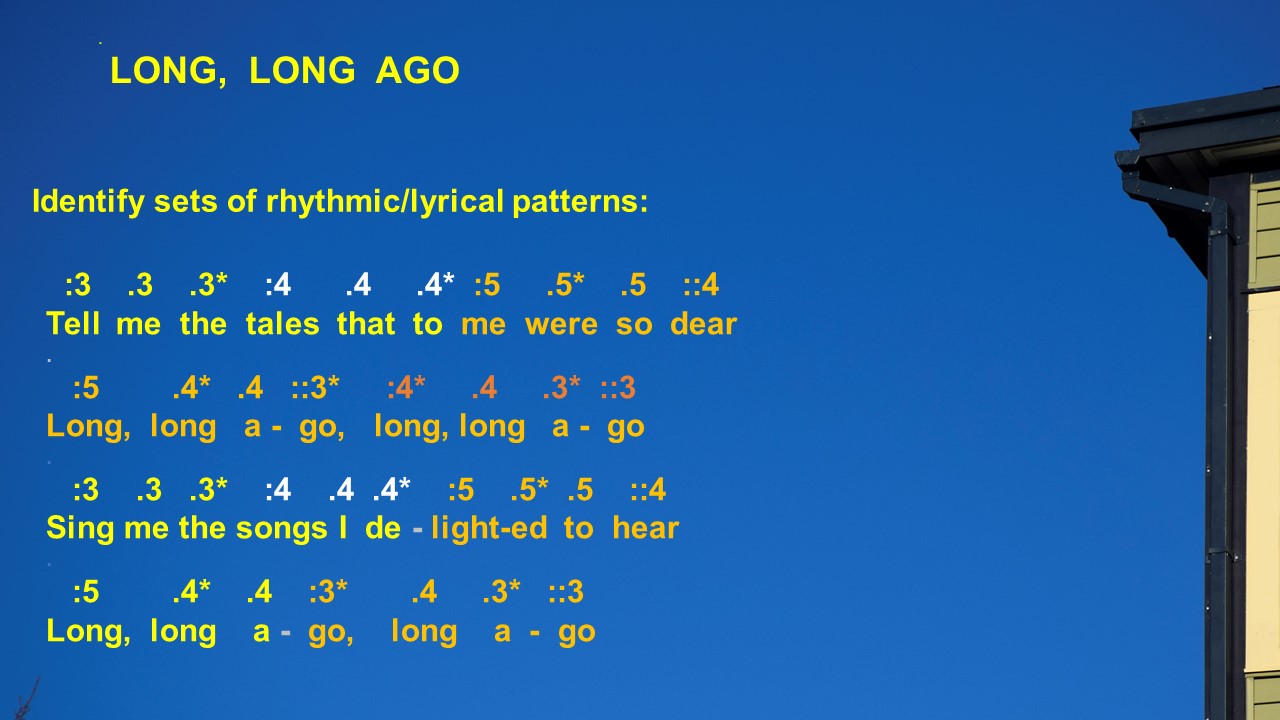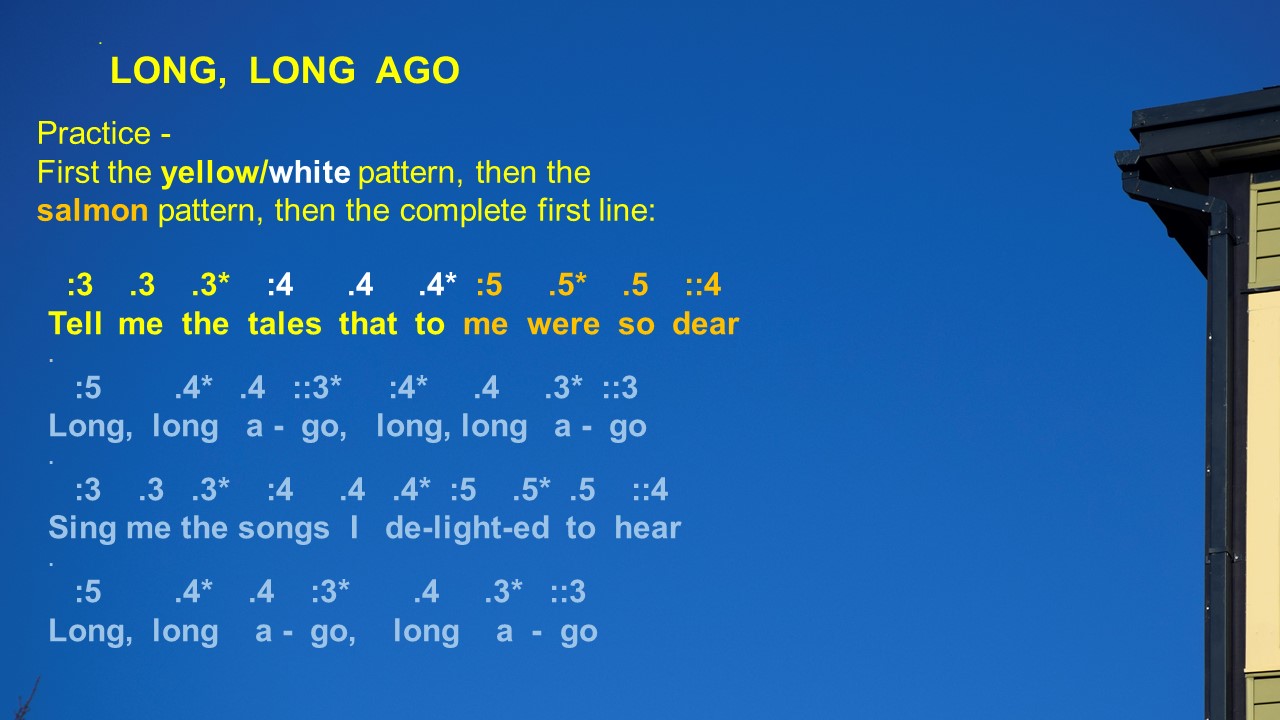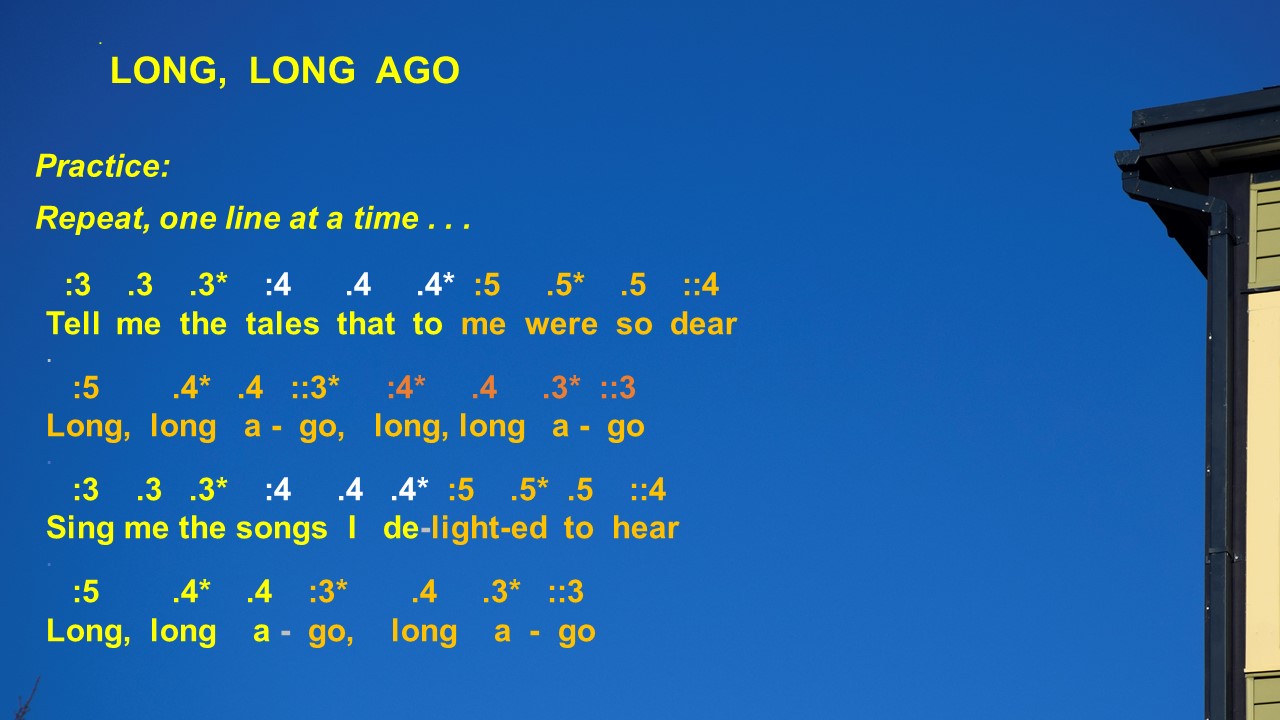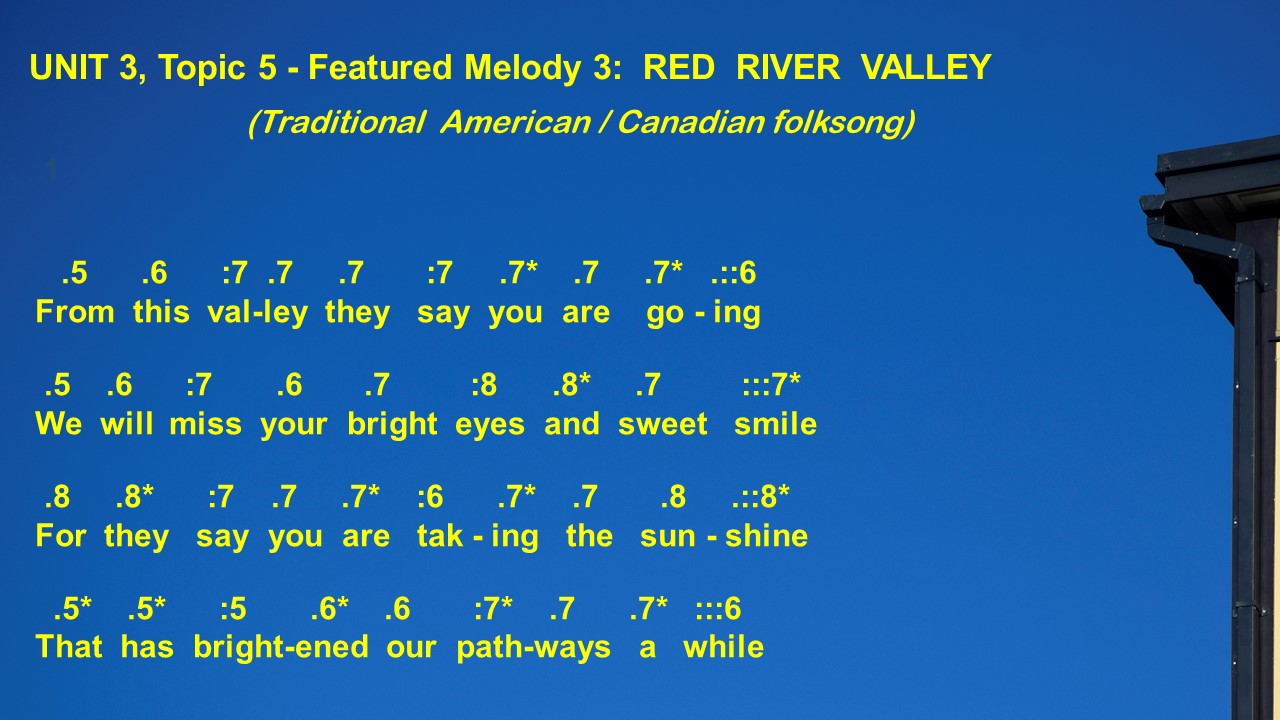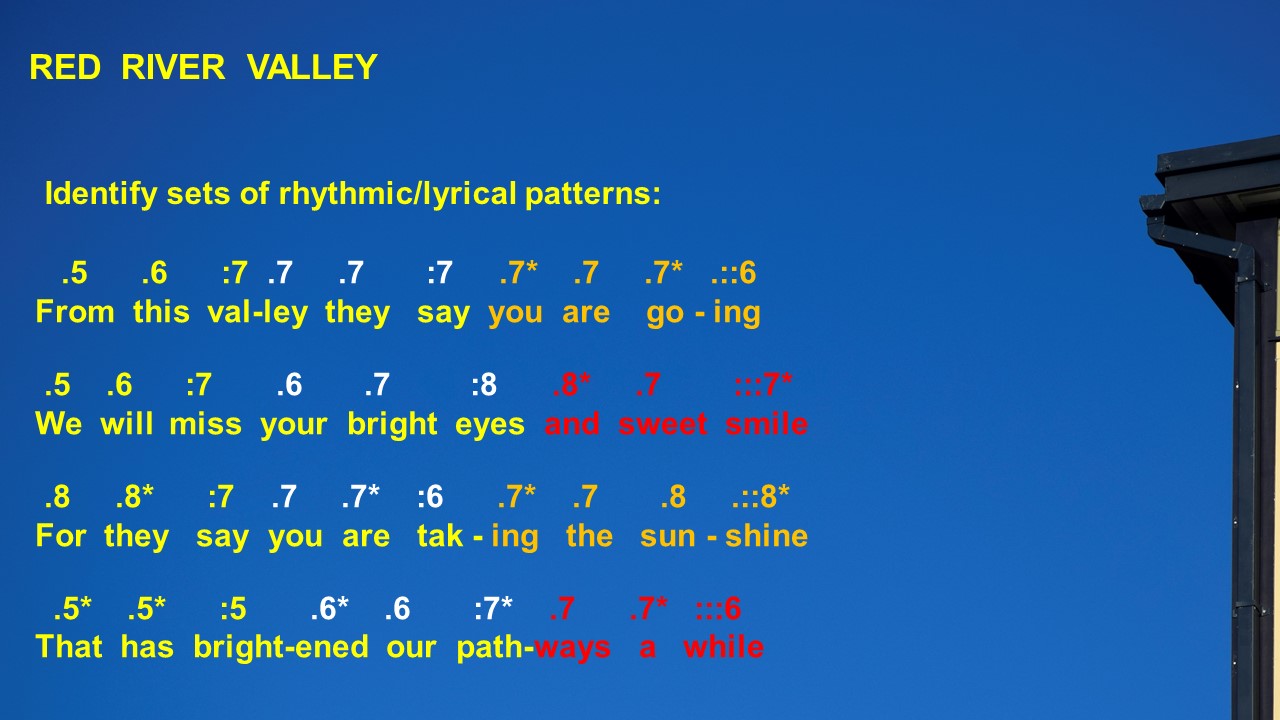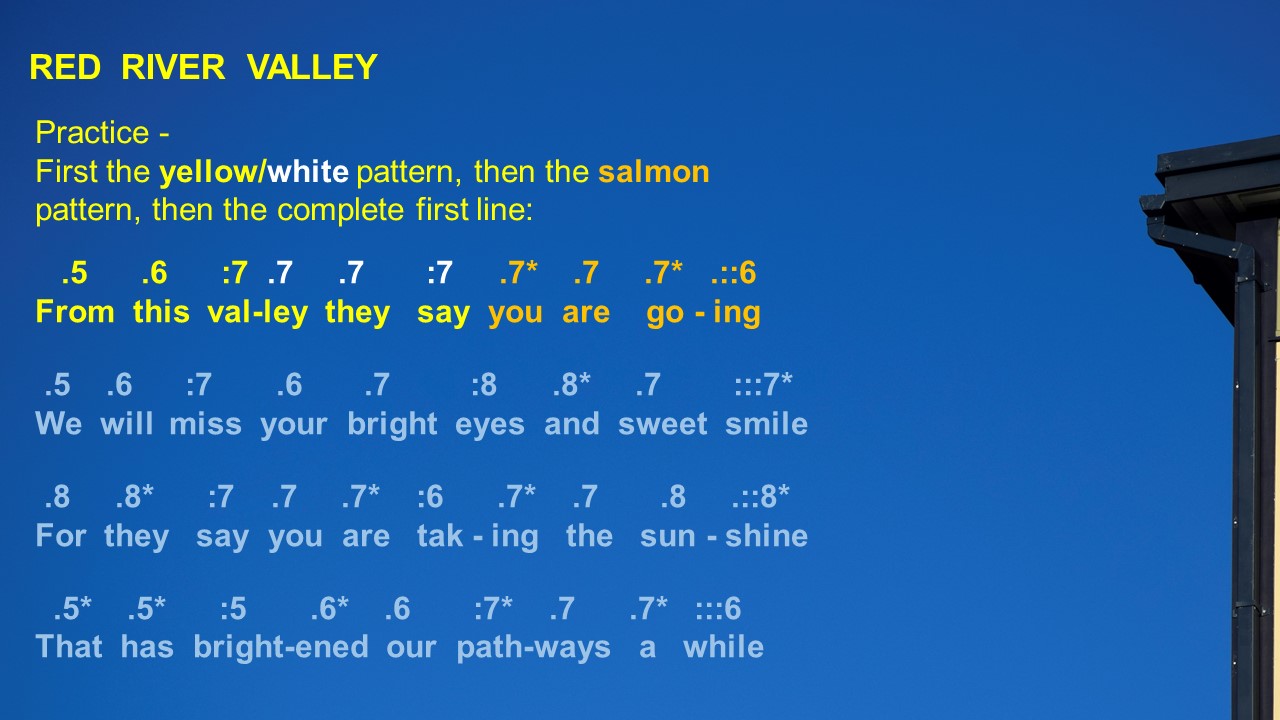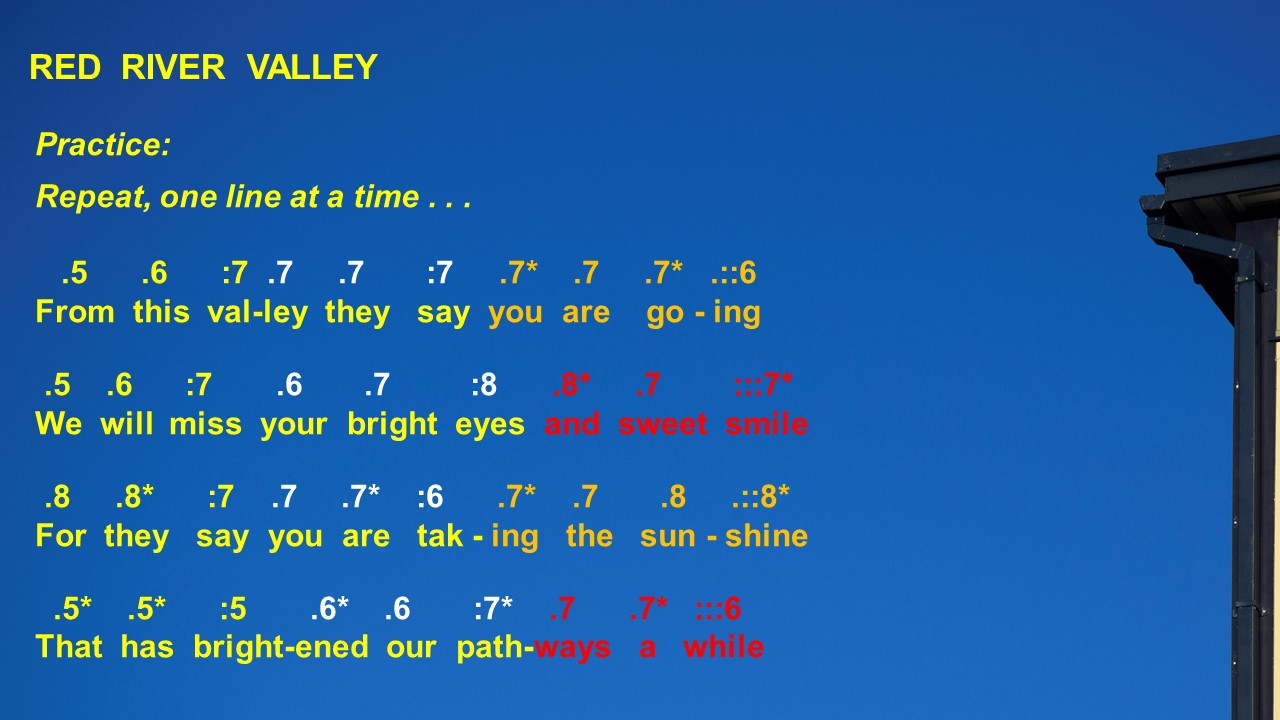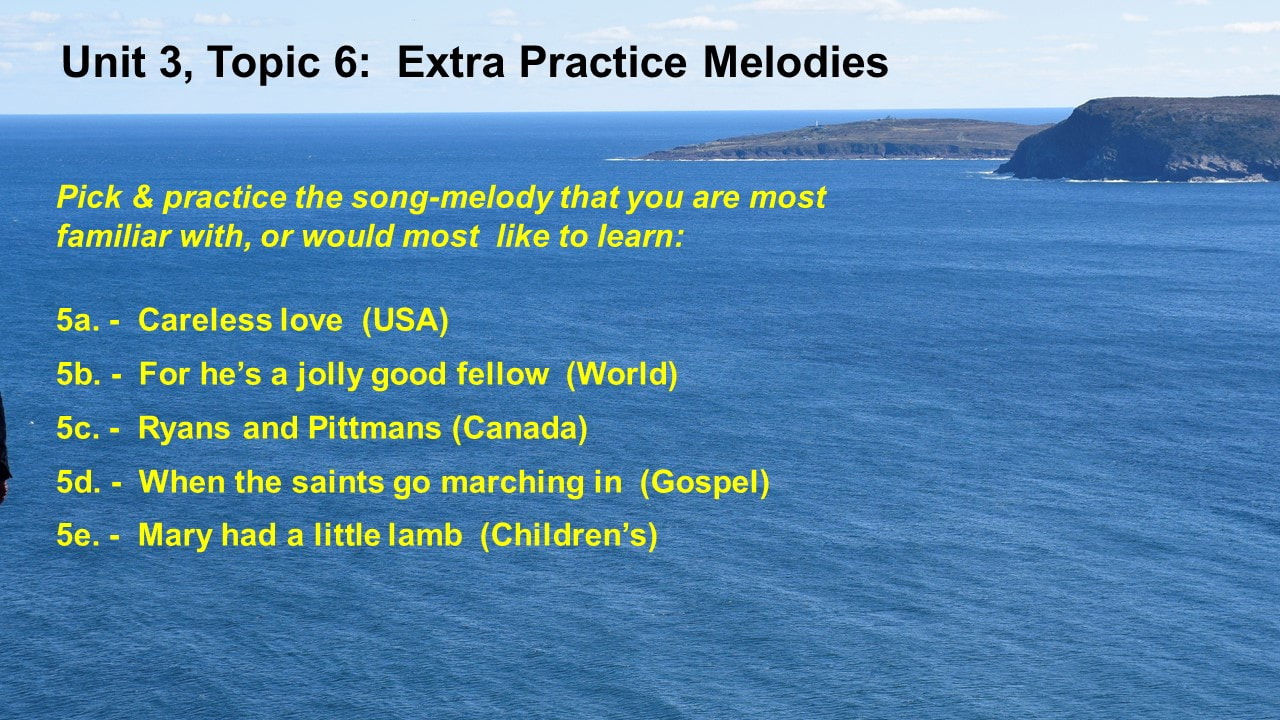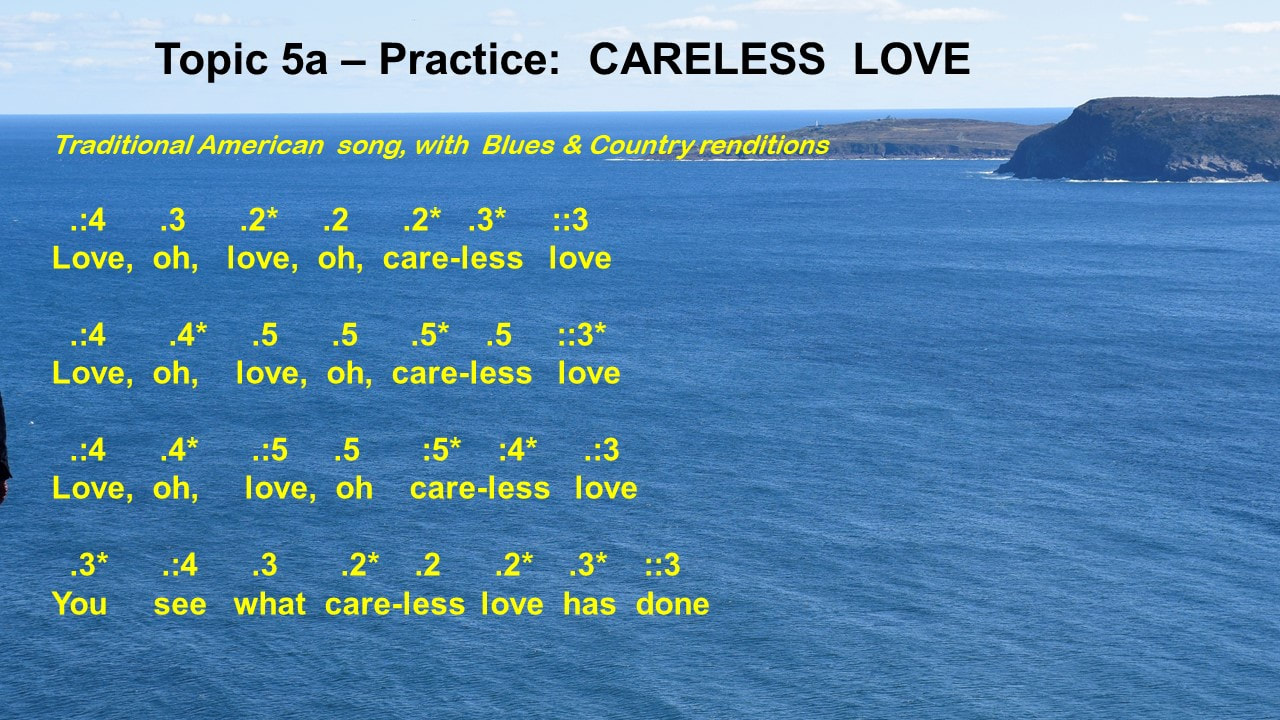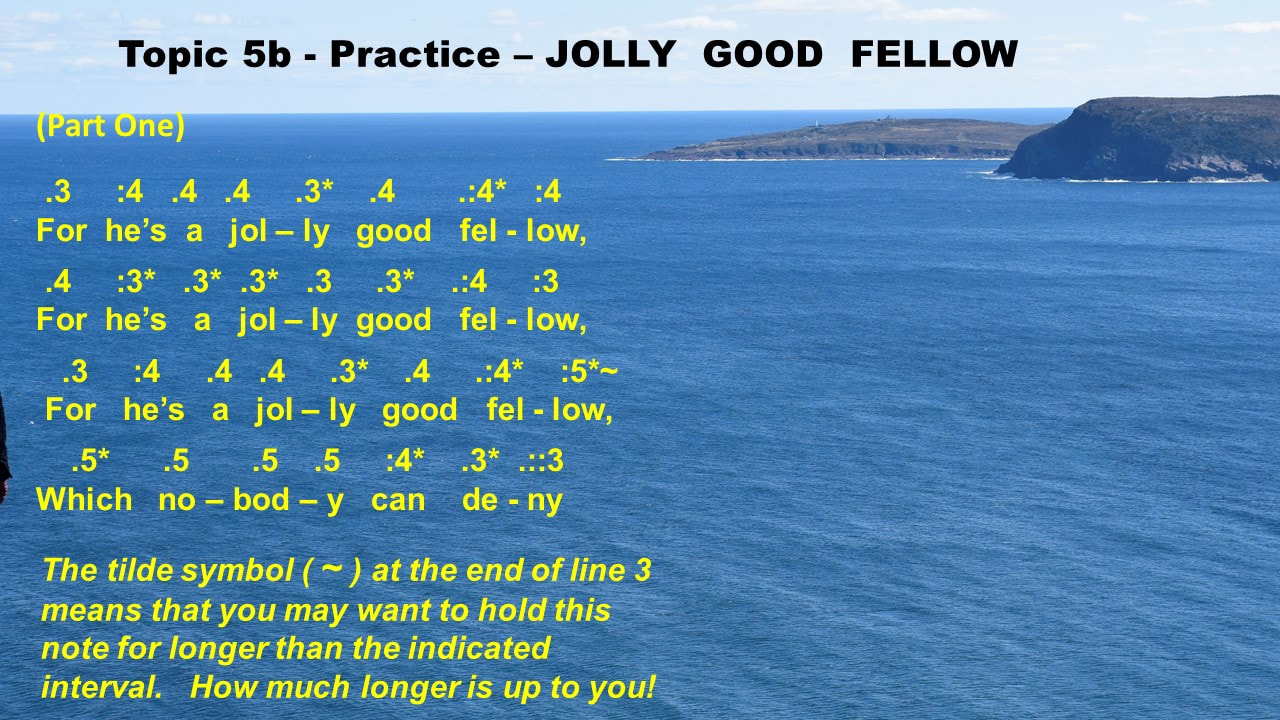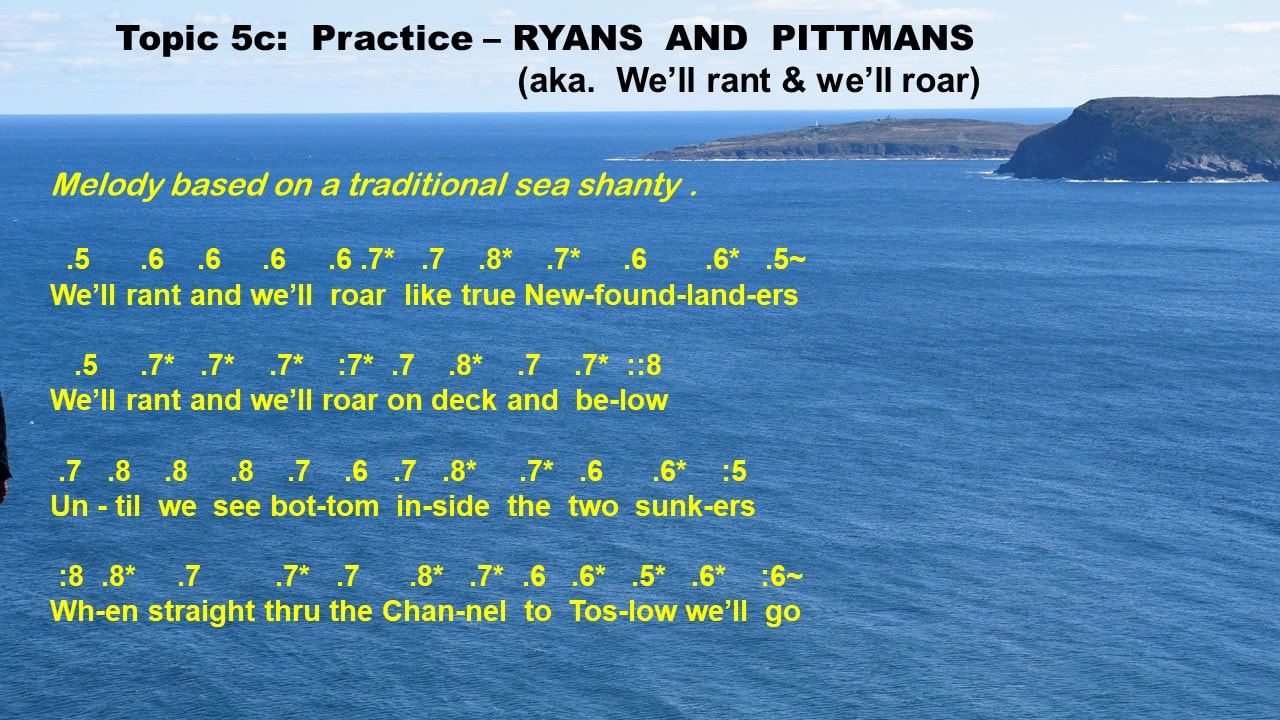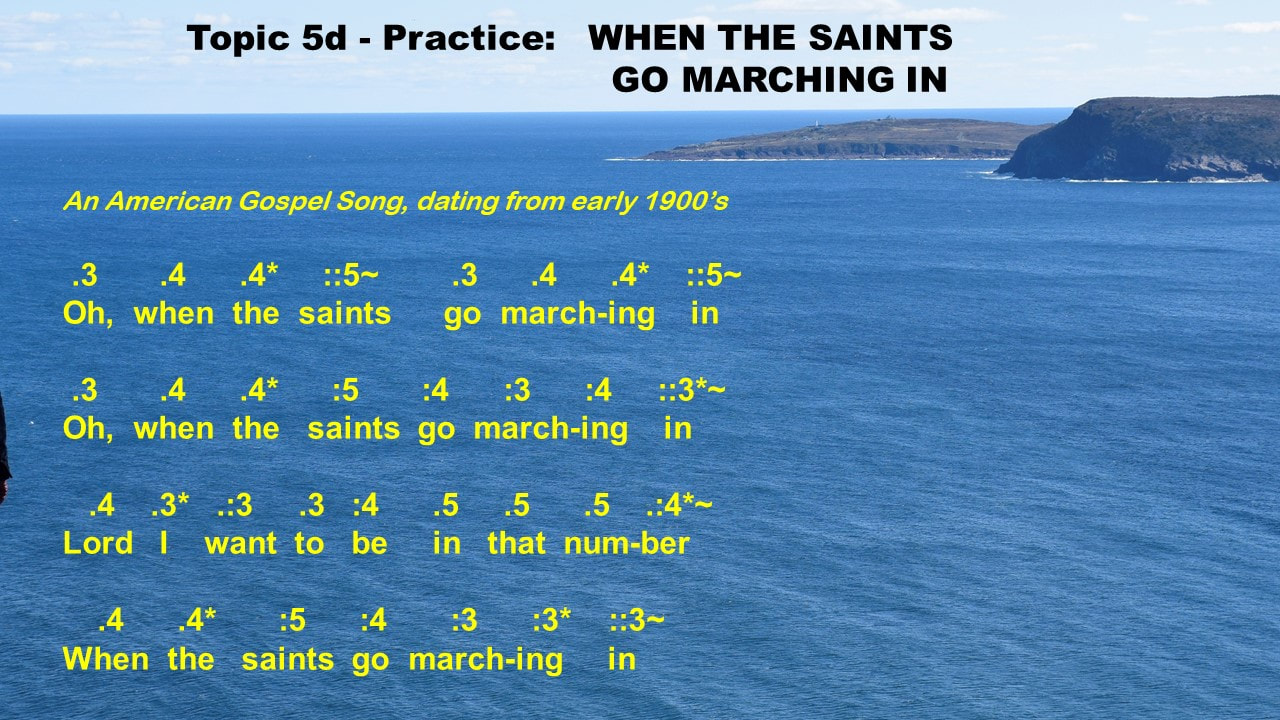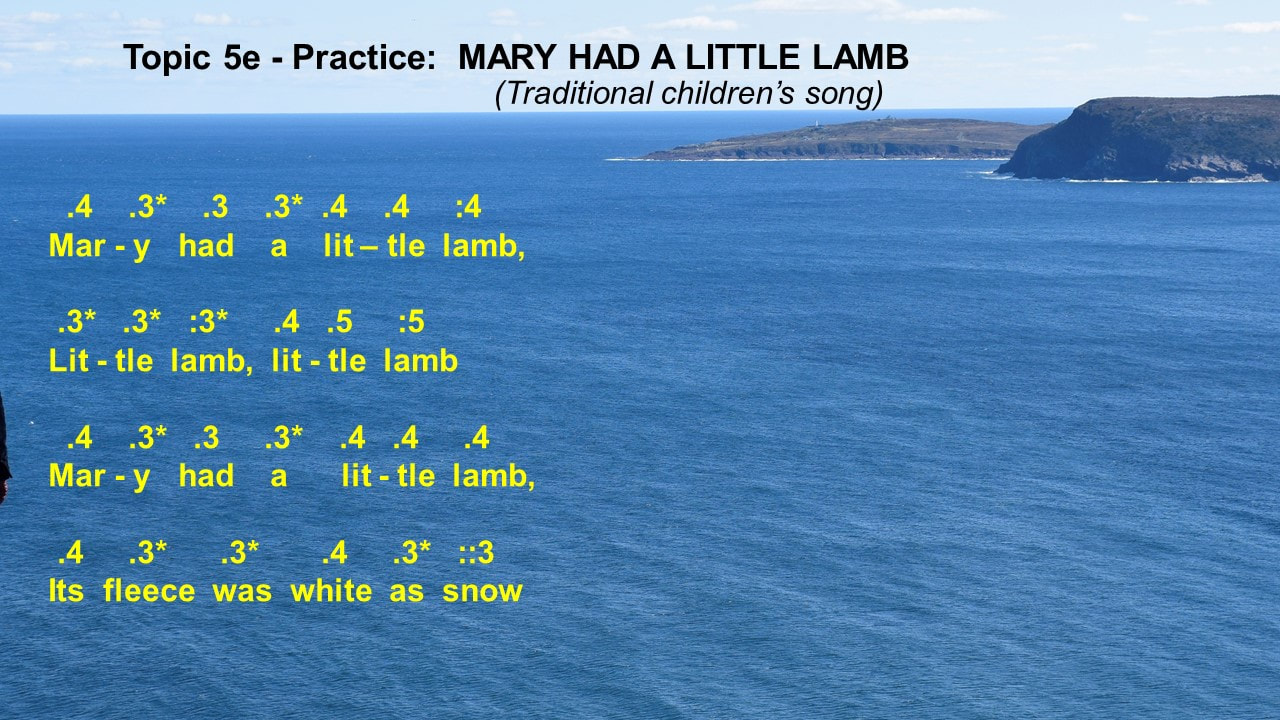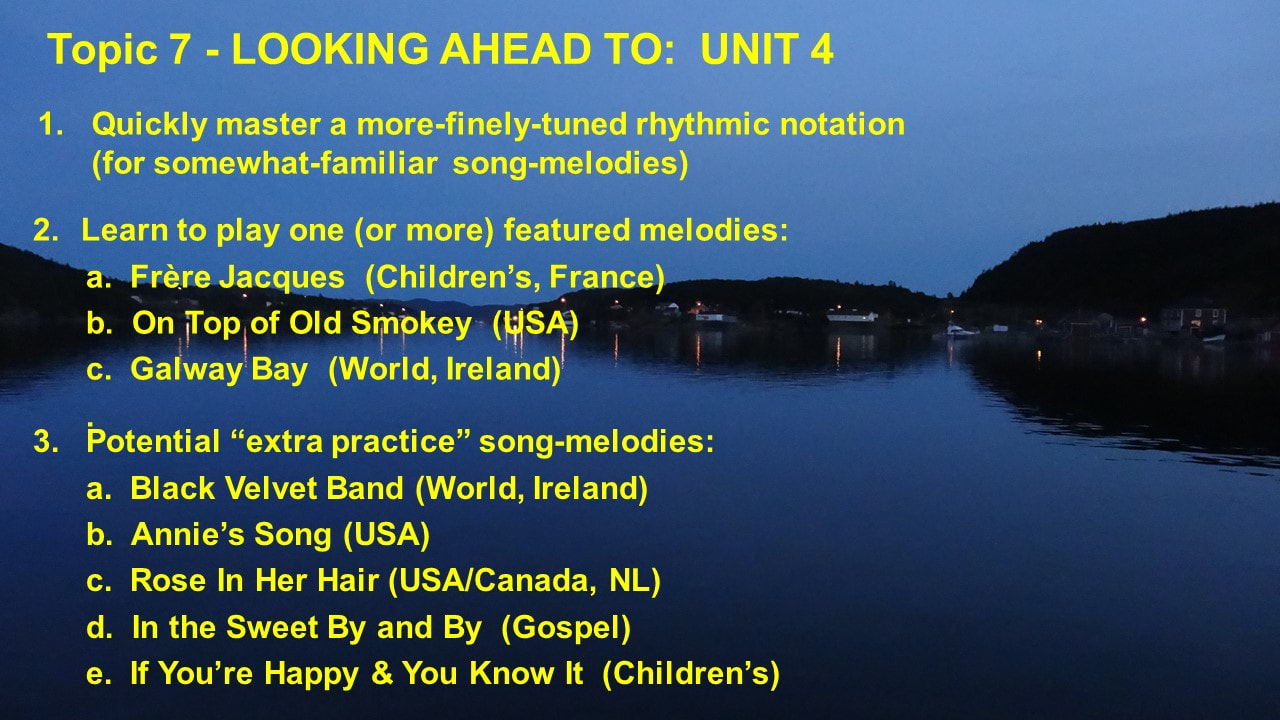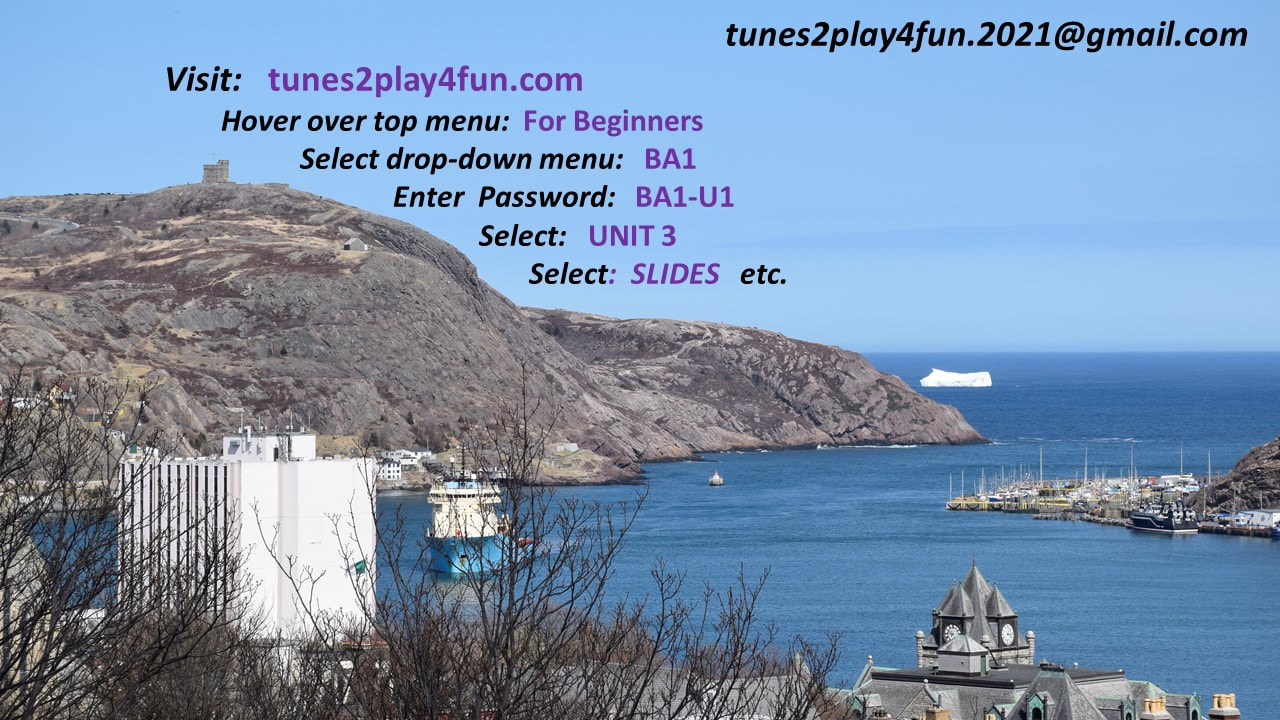Button-Accordion Program
(Dual-row G-C or A-D, with Accidentals)
Based on tunes2play4fun.com & Facilitated by ZOOM
MINI-COURSE BA1
BASIC MELODIES
UNIT TWO (of four)
A Simple Rhythmic Notation
(for playing less-familiar melodies)
(Dual-row G-C or A-D, with Accidentals)
Based on tunes2play4fun.com & Facilitated by ZOOM
MINI-COURSE BA1
BASIC MELODIES
UNIT TWO (of four)
A Simple Rhythmic Notation
(for playing less-familiar melodies)
SLIDES & COMMENTS
Slide 1 (Tutorial Project BA1 - Main goal)
Slide 1 (Tutorial Project BA1 - Main goal)
Slide 2 (Activities)
|
All learning involves (supported) self-teaching, whether in face-to-face or distance environments. Please note the (optional) individual "25-30 minute" Zoom conferences as scheduled with you for Wednesday & Thursday evenings. These are intended to provide tutoring & feedback for you, as and when needed. |
Slide 3 (Six Mini-course Units)
Slide 4 (Topics)
Slide 5
|
Although we going to develop a rhythmic notation for somewhat-familiar melodies,
I'm initially going to make the case using a totally unfamiliar song-melody, the first verse of which is shown at left. I know that this children's composition is one of the world's least familiar song melodies, because no more than about a dozen people have ever heard it performed. |
Using only the lyrics (above), it is near impossible to guess what the composer intended as a suitable melody. We need more info, some of which is given on the next slide.
Slide 6
This rhythm is determined, in part, by how long, in musical time, each note is held.
ASIDE #1: Of course, if it were a very-familiar song-melody, this simple notation might be
sufficient. But this is not a very-familiar song, so it would require timing information.
ASIDE #1: Of course, if it were a very-familiar song-melody, this simple notation might be
sufficient. But this is not a very-familiar song, so it would require timing information.
Slide 7
|
a. A melody is, in part, a series of physical tones, in time, one after the other, forming a set. For the accordion, the tones are emitted by vibrating metal reeds.
b. When placed on paper or a computer screen, we see a melody as a series of notes. The term "note" is often used for both the tone and the note that represents it. |
c. Within melodies there are patterns in the lengths of notes, that is, in the amount of time that
notes are held.
d. Although "melodic rhythm" is difficult to define or describe simply, we can begin by stating that it is related to the patterns of note-lengths in musical time.
notes are held.
d. Although "melodic rhythm" is difficult to define or describe simply, we can begin by stating that it is related to the patterns of note-lengths in musical time.
Slide 8
|
We first need a way of counting and indicating musical time.
The most common unit of musical time is the "beat interval", sometimes lazily referred to as the "beat". d. In music, the "beat" is a regular pulse in time. It could be a: drum beat, guitar strum, foot tap, metronome click, etc. (real or imagined) |
e. The "beat interval" is the period of time from the beginning of one pulse to the beginning of the next, or from mid-point of one pulse to the mid-point of the next, or ....
f. The beat interval can be related to clock time by giving the number of beats per minute, sometimes called the "tempo" of the melody. Alternately it is sometimes referred to as the "pace" or the "speed" of the melody.
g. For melodies that have a simple rhythm, which includes all the melodies in this BA1 mini-course, I have found it convenient to indicate the simple beat interval using a period, or dot ( . ), and place it before the button number in our simple accordion notation. Think of it as a "period of time" being represented by the actual "period" symbol ( . )
ASIDE #2: When, in future mini-courses, we meet more complicated melodic rhythms, it should be easy to adapt or fit our simple "period" notation to those melodies as well.
ASIDE #3: Beat intervals and notation will play a major role in helping us move from melodies (right hand only) to tunes (both hands), where we can play the left-hand bass and chord buttons to generate musical pulses and harmonic enhancement.
f. The beat interval can be related to clock time by giving the number of beats per minute, sometimes called the "tempo" of the melody. Alternately it is sometimes referred to as the "pace" or the "speed" of the melody.
g. For melodies that have a simple rhythm, which includes all the melodies in this BA1 mini-course, I have found it convenient to indicate the simple beat interval using a period, or dot ( . ), and place it before the button number in our simple accordion notation. Think of it as a "period of time" being represented by the actual "period" symbol ( . )
ASIDE #2: When, in future mini-courses, we meet more complicated melodic rhythms, it should be easy to adapt or fit our simple "period" notation to those melodies as well.
ASIDE #3: Beat intervals and notation will play a major role in helping us move from melodies (right hand only) to tunes (both hands), where we can play the left-hand bass and chord buttons to generate musical pulses and harmonic enhancement.
Slide 9
|
If you are completely familiar with a song melody, then you instinctively know how long to hold each note, and do not need notation such as this.
However, if you are only slightly or somewhat familiar with a melody (which, for me, is often the case), this simple notation can be very useful. This one-line example of a very familiar melody may make this clearer. |
ASIDE #4:
Q: How long is a beat interval in seconds or fractions of a second?
A: Beats don't have any absolute time in seconds or fractions of a second.
When first performed, it is often up to the composer, or the music director, or the band leader, or the first performer.
A: Beats don't have any absolute time in seconds or fractions of a second.
When first performed, it is often up to the composer, or the music director, or the band leader, or the first performer.
ASIDE #5
The length in real time, in seconds or fraction of a second, of a beat interval can be quite different in different songs, even for different performances of the same song that follow the same rhythmic patterns.
It is really up to the individual performer, for solos, or up to the group (or group leader) or conductor, for band, choir or orchestral performances.
The length in real time, in seconds or fraction of a second, of a beat interval can be quite different in different songs, even for different performances of the same song that follow the same rhythmic patterns.
It is really up to the individual performer, for solos, or up to the group (or group leader) or conductor, for band, choir or orchestral performances.
Slide 10
Slide 11
Slide 12
|
I should stress that rhythmic patterns are an important part of music. The creative combination of both pattern variety and repetition makes for interesting and enjoyable music.
Here, however, our initial interest is in using these rhythmic patterns as a learning aid, helping us to break verses and lines of music into smaller units or chunks, each of which can be practiced separately, and then combined. |
Slide 13
|
All learning (self-teaching) starts with the familiar, and no song-melody is more familiar than the Birthday Song. And so it is that we begin with it.
There is no fixed key (which , for us, means accordion row & type (G/C or A/D, etc.) and no fixed tempo or pace for playing this melody, or for singing it. Also there is no fixed amount for the length of time you hold the final note in line 3. Much is up to you. |
Slide 14
|
At this stage, identify the patterns that are most useful to you.
For the beginner, perhaps the 1st two notes (.5 .5) could be considered a basic pattern. For a more experienced player, perhaps the whole first line could be considered as a single pattern, with repeats on lines 1,2, & 4 What is shown at left lies be-tween these two approaches. |
Slide 15
Slide 16
|
This is an old English tune, from 1833. It can be played either high or low on either the inside or the outside rows. The button notes given here are for playing it using the lower octave. The web site gives the button notes for both the lower and higher octaves.
Verses 2, 4 & 6 (included in this "for beginners" section) use a different melody for their first two lines, and are not formally part of this section. |
Slide 17
Slide 18
Slide 19
Slide 20
|
This is an American and a Canadian song, as both have a number of "red" rivers, one of the largest of which originates in the United States, and flows through Manitoba, emptying into Lake Winnipeg (which empties into Hudson Bay via the Nelson River).
It is also a popular song world-wide, as many countries have "red" rivers. |
Slide 21
|
There are different ways of dividing the verse into rhythmic units and patterns.
The (.5 .6 :7) at the start of the first line appears twice on each of the four lines. Another pattern (.7* .7 .7* .::6) is found on the 1st & 3rd lines. A third pattern (.8* .7 :::7*) is found on the 2nd & 4th lines. Remember it is the beat pattern, not the button notes that determines the rhythm. |
Slide 22
Slide 23
Slide 24
Slide 25
Slide 26
|
According to the Guinness world records, this is the 2nd most popular song in the English-speaking world.
The melody is of French origin, with English & American lyrics dating from the 1800s. Note the tilde (~) symbol at the end of line 3. This indicates that this note may be held for longer than the two beat intervals shown. |
Slide 27
|
This is the first verse of a popular NL folk song and dance tune, known to some as "The Ryans and Pittmans" and to others as "We'll rant and we'll roar like true Newfound-landers." Played lively!
The melody is based on the English sea shanty "Spanish Ladies" and some of the verses were adapted from the American "Yankee Whalermen". The NL verses were composed by Henry W. Lemessurier. |
Slide 28
Slide 29
|
Each unit will also include a children's song for those of you who may have young children or grandchildren, and who may be amused to hear you playing one of their melodies.
"Mary had a little lamb" is a very popular song for young children, and a melody that's quite well known to anyone who has young ones. |
Slide 30
|
We have just covered notes with an integral (1, 2, 3, etc.) number of beats in length; no fractions.
In Unit 4 we will improve the notation to take account of notes that are a fraction of a beat interval in length (1/4, 1/2, and 3/4 of a beat). Unit 4 contains three featured and five (optional) extra practice melodies containing such fractional notes. |
Slide 28 (Links & password)
